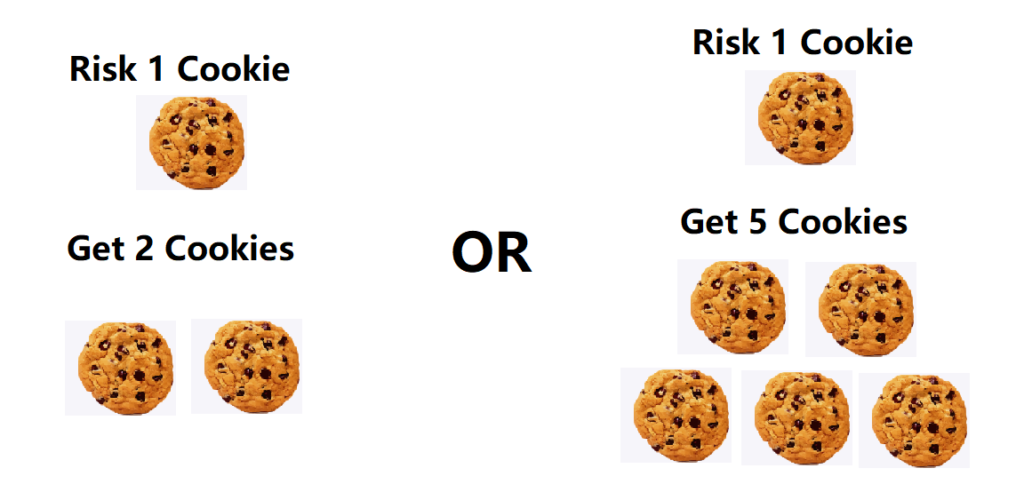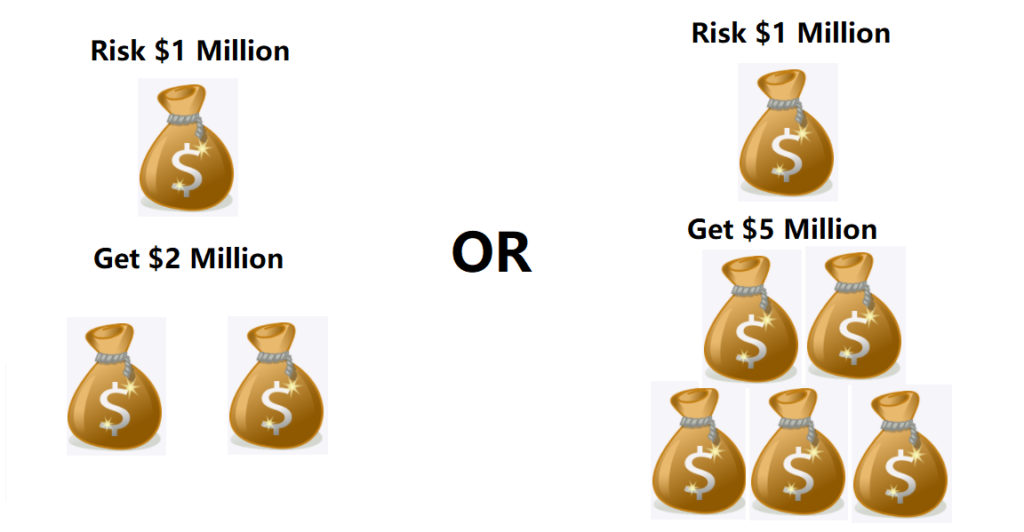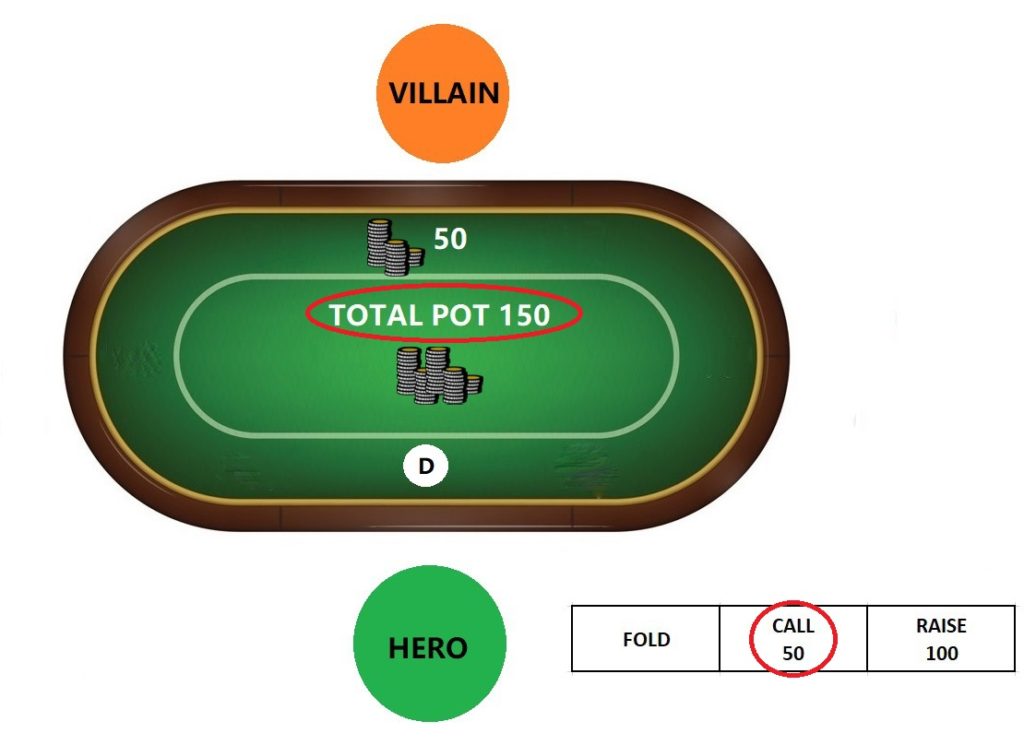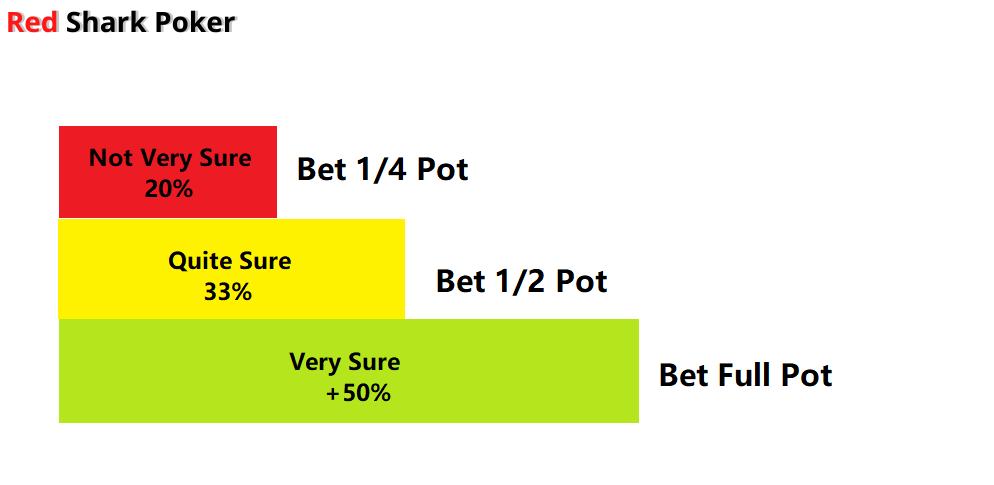

Let’s talk about math!
Wait! Don’t go! We know math can be super boring and nerdy, but using math can significantly improve your game. Still not interested? How about this – You can make more MONEY by using math in your game!
Also, we will teach you some poker math hacks to do the calculations in seconds without using a calculator or software.
So, let’s start!
There are many mathematical concepts used in poker. Some are way too complicated and quite impossible to use in real-time. We will skip those. We will only focus on the essential poker math that you must use to determine how likely you are going to win pots. And, it’s super easy to calculate as well!
Pot Odds
We are going to give you two options.

Obviously, you will choose the second option as you are getting 5 cookies for risking one. If we change the cookie to a million dollars?

Notice any difference? The values have changed, but the ratio between the reward and risk is still the same. If you have noticed this difference, you have already grasped the meaning of pot odds!
Pot odds is a mathematical expression of risk and reward. Pot odds tell you how much do you need to risk in order to win a reward. It is the ratio between the reward and the risk.
Reward = Pot to be Won
The pot can be at any point of the game – preflop, flop, turn or river.
Risk = How much you need to risk in order to win the pot
The risk is the size of someone’s bet/raise/re-raise you are facing. It is the amount you need to call in order to win the pot.
Pot odds = Reward : Risk
It is the ratio of the size of the pot (reward) to the amount you have to call (risk).
If there is $6 in the pot and your opponent bets $3, the pot becomes $9. In order to win the pot of $9, you need to call $3. So, what are the pot odds?
Reward = $9 (Size of the Pot)
Risk = $3 (Size of the Call)
Pot Odds = $9(Reward):$3(Risk)
= 9:3, which can be simplified to 3:1
Hence, the pot odds are 3:1. You can look at these odds in two ways.
- You need to pay 1/3 of the pot for a chance to win the whole pot
- You will get 3X the reward of your risk
Pot odds give you a clear picture of how much you are likely to be rewarded for the risks you take.
Quick Poker Math Hacks to Calculate Pot Odds
If the pot odds are 5:1, the second number (risk) is always 1. So, you just need to find the first number (reward). For that, just look at the poker table to see what’s the total pot and the call amount. If the pot is $100 and the villain bets $50, the total pot is $150. Most of the online poker sites show the Total Pot on the table. So, there is no need to calculate it.

Total Pot = 150
Call = 50
Divide the Total Pot by the Call Amount
150/3
= 3
So, 3 is the first number in pot odds. As the second number is always 1, the pot odds are 3:1.
What about Complex Calculations?
Let’s say the total pot is $697, and the call amount is $198.3; it might take some time to do the division. When you see such numbers, round off the call amount and multiply by itself to see how close you are getting to the total pot.
- Round off 198.3 to 200.
- Multiply 200 by 2 and we get 400, which is not close to 697.
- Multiply 200 by 3 and we get 600, which is not close to 697.
- Multiply 200 by 3.5 and we get 700, which is close to 697.
When you use such poker math hacks, you can see that you are getting nearly 3.5 times the reward for the risk you take. So, the pot odds are 3.5:1.
How to Use Pot Odds?
Pot odds are usually used while facing bets or raise, especially while chasing draws. You have an unmade drawing hand with outs that can improve your hand. When you face a bet, you can compare the pot odds with equity to see whether calling or chasing draws would be profitable in the long run.
Let us first learn about equity.
What is Equity?
Equity, also known as pot equity, is the rightful share of the pot that belongs to you based on the chances of winning the hand at the current point in the play. Thus, equity changes on the preflop, flop, turn and river.
You can say that “equity” is a fancy word used for your winning percentage. For example, when you say pocket aces (AA) have 81% equity over another pair on the preflop, you are saying that you have an 81% winning chance on the preflop with pocket aces. If you specifically want to talk about pot equity, then your pocket aces will have $81 equity in a pot of $100.
How to Calculate Equity While Chasing Draws?
The Rule of 4 and 2 is the easiest and most common way of calculating equity on the fly. In order to use this method, you need to first find the number of outs. If you don’t know how to calculate outs, you can click here: How to Calculate Outs in Poker?
The Rule of 4 and 2 states:
Equity on the Flop waiting for the Turn = Number of Outs X 4
Equity on the Turn waiting for the River = Number of Outs X 2
It’s that simple! Let’s look at an example to calculate the equity using the rule of 4 and 2.
Your Hand: 3♦ 4♦
Flop: 8♦ K♣ 2♦
We have a flush draw with 9 outs. So, when we are on the flop waiting for the turn, we have 36% equity.
Equity on the Flop = 9 outs x 4
= 36%
Turn: 8♦ K♣ 2♦ 10♠
We still have a flush draw with 9 outs. So, when we are on the turn waiting for the river, we have 18% equity.
Equity on the Turn = 9 outs x 2
= 18%
Compare Equity and Pot Odds
You must follow this golden rule while chasing draws in poker:
Equity Should be Greater than Pot Odds
When you are facing a bet with an unmade drawing hand, you must check whether your equity is greater than the pot odds. You should call only when the equity is greater than the pot odds.
In order to compare the pot odds and equity, you must convert the pot odds, which is in a ratio, into a percentage.
How to Convert Ratio into a Percentage?
- Add the two numbers in the pot odds ratio. For example, if the pot odds are 3:1, then add 3 + 1, which is equal to 4.
- Divide 100 by the result of the addition.
100/4 = 25
3:1 = 25%
It can be a bit difficult to do the addition and division in real-time. So, you can memorize the most common pot odds ratio and its corresponding percentages by looking at the chart below:
| Pot Odds (Ratio) | Pot Odds (Percentage) |
| 5:1 | 17% |
| 4:1 | 20% |
| 3.5:1 | 22% |
| 3:1 | 25% |
| 2.5:1 | 29% |
| 2:1 | 33% |
| 1.5:1 | 40% |
What if the Pot Odds are 2.8:1?
2.8:1 lies between 2.5:1 and 3:1. So, you can assume that pot odds would be anything between 25% and 29%. This will give you a general idea of what the pot odds percentage will look like.
Let us look at an example to check whether you should chase your draws.
Your Hand: 6♠ 7♠
Turn: A♠ Q♥ 2♠ 10♣
Opponent bets $200 into a $200 pot. The total pot is $400.
You are quite sure that your opponent has hit something on the board, but you still have 9 outs that can improve your hand to a flush. Let’s calculate the equity and pot odds.
Equity on the Turn waiting for the River = Number of Outs X 2
= 9 X 2
= 18
Equity = 18%
Pot Odds
Find the first number of the pot odds ratio
= Total Pot/Call Amount
= 400/200
= 2
So, the pot odds are 2:1.
Now, we need to convert the ratio into a percentage. If we look at the chart above, 2:1 gives us 33% pot odds.
According to the rule, your equity should be greater than pot odds. However, in this case, our pot odds are greater than equity.
33% (pot odds) > 18% (equity)
You still have 9 outs, but calling here won’t be profitable in the long run. You will be losing more than winning in the long run if you call here. As we are getting incorrect pot odds, we should fold here.
Break-Even Percentage
Do you know that you can use math while bluffing? You can find the break-even percentage in poker to calculate how much you need to bet in order to execute a successful bluff.
What is Break-even Percentage?
Break-even percentage in poker is used to find out if your call, bet or raise will have a profitable outcome. If your action works more than the break-even percentage (BE%), you can expect a profit; and if your action works less than BE%, you can expect a loss.
- More than BE% = Profit
- Less than BE% = Loss
Break-Even Percentage = Risk/(Risk + Current Pot)
If the current pot is $100 and you decide to bluff by making a half-pot size bet ($50), what will be the break-even percentage in poker? Let’s use the simple formula to find out!
Current Pot = $100
Risk = $50 (Bet)
BE% = Risk/(Risk + Current Pot)
= 50/(50 + 100)
= 50/150
= 0.33
So, the break-even percentage of your bluff is 33%. If your opponent folds more than 33% of the time, you will earn a profit by winning the pot. If your opponent folds less than 33% of the time, you will lose the pot as your opponent might call.
Opponent Folds More than 33% = Profit
Opponent Folds Less than 33% = Loss
How to Use Break-Even Percentage while Bluffing?
For any bluff to work, you must have a good read on your opponent. You must know how likely your opponent is going to fold to your bet or raise. In other words, you need to know the percentage of your opponent folding. When you know your opponent’s fold percentage, you can use the break-even percentage to find out how much you should bet to expect a profit.
Opponent’s Fold Percentage
It is quite impossible to accurately predict the exact percentage of your opponent folding. If you are using a HUD, you can get a close estimate of your opponent folding to your bet or raise on different streets.
We have calculated the break-even percentage for different fold percentages for you. Download the poker math hacks chart below or memorise the numbers to know much to bet in order to expect a profit.
| Opponent’s Fold Percentage | How Much to Bet? |
| 20% | 25% of the Pot (1/4 Pot) |
| 25% | 33% of the Pot (1/3 Pot) |
| 33% | 50% of the Pot (1/2 Pot) |
| 40% | 67% of the Pot (2/3 Pot) |
| 43% | 75% of the Pot (3/4 Pot) |
| 50% | 100% of the Pot (Full Pot) |
| 67% | 200% of the Pot (2X the Pot) |
Easy Poker Math Hacks to Know How Much to Bet?
If you don’t use a HUD, you need to ask yourself, “Will your opponent fold?” The answer will help you in finding the right bet size.
| Will Your Opponent Fold? | Fold Percentage | How Much to Bet? |
| Not Very Sure | 20% | 1/4 Pot |
| Quite Sure | 33% | 1/2 Pot |
| Very Sure | +50% | Full Pot |

Bottom Line
There are more complex mathematical concepts like Expected Value, Implied Odds and Reverse Implied Odds whose calculations are quite impossible to do in real-time. However, the basic math like pot odds, equity and break-even percentages are a lot easier to perform if you use the poker math hacks mentioned in this article.
Poker math does not guarantee victory, but it can power up your game. You will drastically improve your game as you won’t be making arbitrary decisions based on luck. Instead, you will be playing a game of skill where you will be making mathematically informed decisions by using the poker math hacks.
When you see the results, you will end up saying, “I Like Math.”








